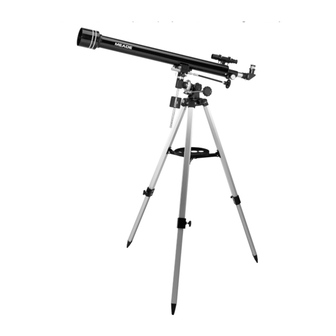Summary of Contents for Meade Polaris 60EQ-D
- Page 1 Instruction Manual Polaris 60EQ-D: 2.4" (60mm) Equatorial Refracting Telescope Meade Instruments Corporation 6001 OAK CANYON, IRVINE, CALIFORNIA 92618-5200 U.S.A. (949) 451-1450 FAX: (949) 451-1460 www.meade.com © 2000 Rev. A 6/02...
- Page 2 ONE YEAR from the date of original purchase in the U.S.A. Meade will repair or replace a product, or part thereof, found by Meade to be defective, provided the defective part is returned to Meade, freight-prepaid, with proof of purchase.
-
Page 3: Table Of Contents
Applications of the Telescope ........ - Page 4 Figure 1: Polaris 60EQ-D 2.4" Equatorial Refracting Telescope 1. Accessory tray 2. Tripod legs 3. Leg brace/accessory tray supports 4. Tripod-to-mount base attachment point 5. Diagonal mirror 6. Eyepiece 7. Viewfinder bracket 8. Viewfinder 9. Viewfinder collimation screws 10. Optical tube saddle plate 11.
-
Page 5: Introduction
7. Tilt the polar axis (15) of the telescope to roughly a 45° angle with the horizon, as shown in Fig. 1. This tilt is accomplished by first loosening the lock control at (24); this lock control, called the “Latitude Adjustment Lock”... -
Page 6: Aligning The Viewfinder
BALANCING THE TELESCOPE In order for the telescope to move smoothly on its mechanical axes, it must first be balanced as follows: Note: If the counterweight is positioned as recommended on the previous page—the telescope is already approximately balanced. -
Page 7: Lining Up With The Celestial Pole
Right Ascension and Declination, the task of finding objects (in particular, faint objects) in the telescope can be simplified. The setting circles, R.A. (16) and Dec. (13) of the Polaris 60EQ-D telescope may be dialed, in effect, to read the object’s coordinates, positioning the object in the vicinity of the telescope’s telescopic field of view. -
Page 8: Polar Alignment Of The Equatorial Mount
For the purposes of casual visual telescopic observations, lining up the telescope's polar axis to within a degree or two of the pole is more than sufficient: with this level of pointing accuracy, the telescope can track accurately by slowly turning the telescope's R.A. flexible cable control and keep objects in the telescopic field of view for perhaps 20 to 30 minutes. -
Page 9: Applications Of The Telescope
APPLICATIONS OF THE TELESCOPE The Polaris 60EQ-D may be used for a lifetime of rewarding astronomical observing, but basic to your enjoyment of the telescope is a good understanding of the instrument. Read the above instructions carefully until you understand all the telescope’s parts and functions. -
Page 10: Calculating Power
The focal length of the Polaris 60EQ-D is 900mm. To compute power, divide the focal length of the eyepiece into the focal length of the objective lens. The resulting quotient is the magnifying power of the telescope when used with the eyepiece in question. -
Page 11: Specifications
Mounting Type ......Equatorial OPTIONAL ACCESSORIES See your Infinity or full-service Meade dealer for further details on any of these accessories. Additional Eyepieces (.965"): Meade recommends the following eyepieces for enhanced astronomical and/or terrestrial viewing: •...














